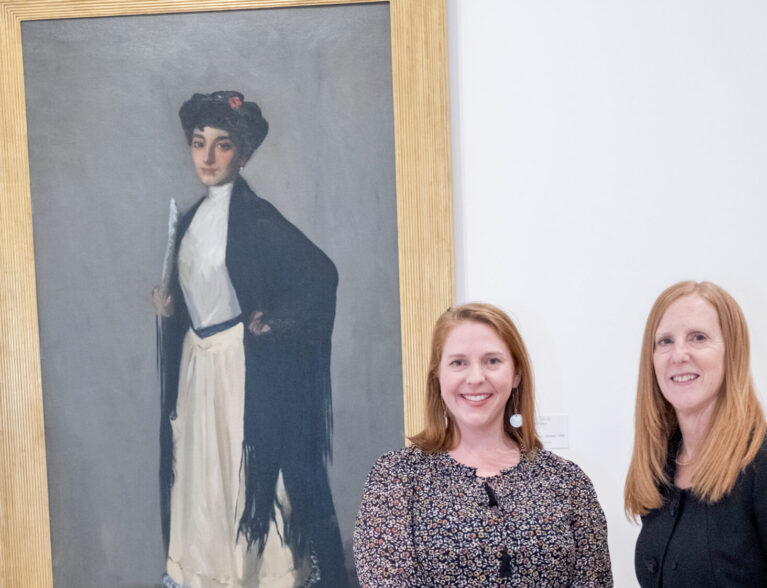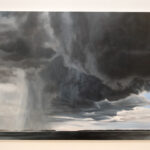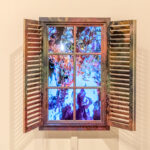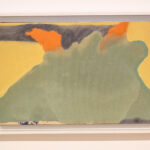
With their choice of Modiste (Spanish Girl, Madrid) 1906, a majestic, full-length portrait by American artist Robert Henri (1865-1929), members of the Athena Society of the Vero Beach Museum of Art voted in April to add a more traditional artwork to the museum’s permanent collection.
The selection follows on the heels of last year’s unconventional choice, Pacific Ocean A, B, C 2022 (triptych) 2022, the fluid AI artwork by visionary artist Refik Anadol (1985).
And, although the two artworks are worlds apart, Henri, in fact, was considered a maverick in his day, trying and rejecting several other art styles, including academic art and impressionism, before embracing his bold, painterly style.
The Athena Society, VBMA members at the Chairman’s Club level or higher, contribute an additional $5,000 per household and, at their annual dinner, are permitted two votes – because spouses don’t always agree – for the privilege of selecting significant art acquisitions for purchase with their pooled funds. Members who join as individuals are also given two votes.
As the intensive selection process took place prior to the March 25 appointment of Caitlin Swindell as VBMA chief curator, the four artworks under consideration were vetted without her, by a committee led by VBMA CEO Brady Roberts.
“There is a lot of research that goes into it,” says Swindell, whose previous position was as curator of collections and exhibitions at the Lowe Art Museum in Coral Gables.
As in the past, the choices were as intriguing as they were disparate. The three not picked were an abstract expressionist painting by another rule breaker, Helen Frankenthaler; a powerful contemporary landscape painting by April Gornik; and a fascinating video sculpture by another trailblazer, Pipilotti Rist.
Swindell says that although none of the artists have works in the permanent collection, some of their contemporaries do, adding, “So there’s dialogue.”
The chosen work, Henri’s Modiste of Madrid, is the second of two that he painted of a young Spanish dressmaker; the first painted from life and the second from memory. The initial version is housed at the Minnesota Museum of American Art, and this version comes to the museum from Debra Force Fine Art.
Although clearly the same young woman, there are noticeable differences in the two, most particularly in color and shading. The first has a murkier background, one side of the girl’s face is in shadow, her apron is a dusky yellow, and her dark fan is pointing down.
The brightened palette of this second one hints at Henri’s experimentation with color theory.
The background is lightened, her face is no longer in shadow and there is a noticeably whiter blouse.
A cream-colored apron – a shoe of the same color is now more visibly peeking out – has noticeably white lace trim and more clearly displays the fringe of her dark shawl.
Additionally, Henri draws the eye to the face by pointing a lighter colored fan upwards, and by the addition of a red rose in her hair.
“It’s a really outstanding example of his body of work and something that would build on the strength of the collection and portraiture of the time period,” says Swindell.
Born Robert Henry Cozad in Ohio (the family changed their names after a scandal involving his father), he studied at the Philadelphia Academy of Fine Art. He would later become a hugely influential teacher at schools in Pennsylvania and New York. According to the Nebraska-based Robert Henri Museum and Art Gallery, Henri is considered to be one of America’s greatest art instructors.
“He and a lot of his contemporaries founded what’s referred to as the Ashcan School, which wasn’t necessarily a school, but a movement of artists focused on the gritty, urban nature of paintings of New York City, of Philadelphia, of city life,” says Swindell.
“But what he became really well known for is portraiture. So, he really has three kinds of styles of his work. The early cityscape type of pieces, bust portraits, like three-quarter-length portraits of people, and then these full body figurative portraits, often of women, though there have been some men as well.”
Many of his works feature subjects from the numerous places he visited throughout his life, including Paris, Spain, Ireland and the American Southwest.
Of those not chosen, Swindell says the piece by American artist Helen Frankenthaler (1928-2011), Untitled, a 1964 acrylic on canvas, is indicative of the changes that were occurring in the art world during that time.
“She is regarded as one of the most significant American abstract expressionist painters. Few artists are credited with inventing a certain style or technique in modern art, but often scholars point the attribution to her that she started this form of stain painting” says Swindell.
Pointing out areas of lighter color washes, she explains that the effect comes from thinning down the paint, whether oil or acrylic, to the consistency of watercolors.
“We think of it now as an abstract painting, sure, but at the time this was huge. This piece is really significant to her career because it follows the year that her work was included in a huge exhibition that Clement Greenberg put on,” says Swindell, referencing the Post-Painterly Abstraction exhibition, which introduced the color field style of abstract painting.
“She was often inspired by nature. This is an untitled piece, but there’s definitely a mountainous feel to the work. I just think it’s incredible for where it is in her career.”
Fast forwarding almost six decades, a third option was The Other Side II, 2022, a vast and powerful oil on linen by American artist April Gornik (b. 1953), who works from a studio in Sag Harbor, N.Y., and tends toward landscapes and seascapes. “This is just an incredible painting, technically. April Gornick has been working in painting landscape for over 40 years,” says Swindell.
“Even in her artist statement, she says it’s stayed the same since right out of college; that she really is inspired by nature and the luminous painters of earlier in the 20th century.”
Swindell says a lot of her pieces start from the reality of an image, before she modifies it with colors and light.
“I like the hints of pink, the sunlight on the horizon, and her use of color; the drama and scale of this piece,” says Swindell.
In the fourth piece, Peeping Freedom for bell hooks, 2023, by Swiss artist Pipilotti Rist (b. 1962), she utilized a similar technology to last year’s selection. It is described as: Video installation, vertical flatscreen, wooden printed window frame with shutters, integrated video player, silent.
The work is part of a Peeping Freedom Shutters series. Pieces in it are each named after prominent women’s rights activists; in this case, the late Gloria Jean Watkins, who used the (uncapitalized) pen name bell hooks.
“What I really like about this piece is it’s definitely identifiable by the artist Pipilotti Rist, who often uses bright colors, new media, technology. They’re like connecting points with the painterly shutters, the physicality of it. The looking-in has almost a voyeuristic feeling for viewers. It’s also just completely mesmerizing,” said Swindell.
“As a creative, I think she is always thinking of new things. It’s something very different. And I love this cinematic quality. Not all video art has that aesthetic necessarily. And she, I believe, started out with an interest in set design, which kind of brought her into film and new media.”
Swindell says that although each of the four works was from a different time period or style, all were equally great choices. “I was so thrilled to come in and see these, because these are some of the best of the best,” she adds.
For more information, visit VBMuseum.org.
Photos by Joshua Kodis












